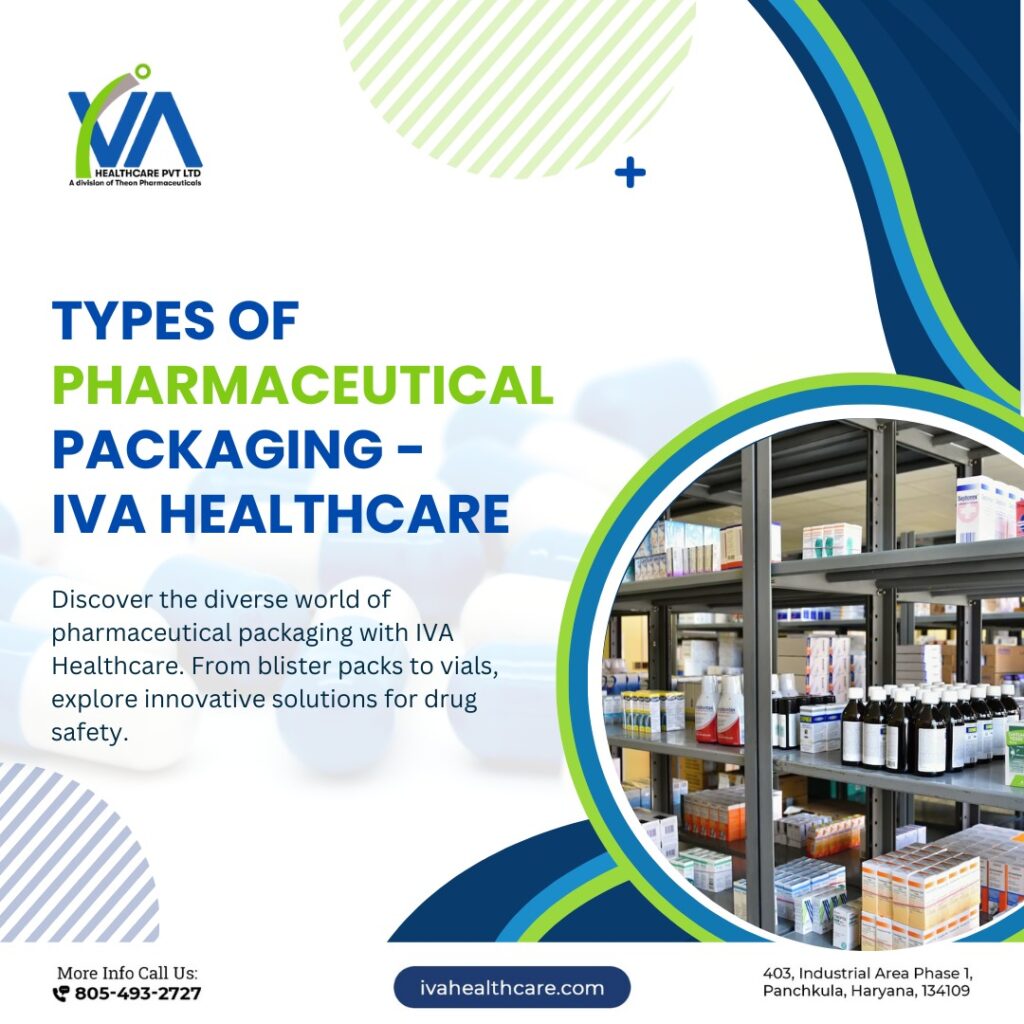The medications we rely on for our health and well-being don’t simply appear on pharmacy shelves. They are carefully encased in specialized packaging that ensures their safety, integrity, and efficacy throughout the supply chain. Pharmaceutical packaging plays a critical role, in safeguarding the product from contamination, degradation, and damage during storage, transportation, and ultimately, reaching you safely.
For PCD pharma franchise businesses, selecting the right packaging is even more crucial. Reliable packaging protects the medication and serves as your brand’s ambassador on pharmacy shelves. At IVA Healthcare, we understand the unique needs of PCD pharma companies and offer a wide range of pharmaceutical packaging solutions that are both functional and cost-effective.
Here, we delve into the different types of pharmaceutical packaging, exploring their functionalities and applications:
1. Primary Packaging: The Direct Contact Guardian
Primary packaging is the first line of defense for a pharmaceutical product. It comes into direct contact with the medication and plays a vital role in:
- Preservation: Protecting the medication from factors like light, moisture, air, and contamination.
- Dosage Control: Ensuring accurate and consistent delivery of the medication in the prescribed amount.
- Safety: Preventing accidental ingestion or misuse, particularly for children or the elderly.
Here are some common types of primary pharmaceutical packaging:
- Blister Packs: These convenient and tamper-evident packs consist of individual aluminum foil pockets with a peelable plastic backing. They are ideal for solid dosage forms like tablets and capsules, offering precise dosage control and protection from light and moisture.
- Bottles: Available in various sizes and materials (glass, plastic), bottles are widely used for tablets, capsules, liquids, and powders. Child-resistant caps are essential for bottles containing medications that could be harmful if ingested accidentally.
- Vials: These small, cylindrical glass containers are often used for injectable medications, sterile solutions, and ophthalmic products. Vials offer excellent protection against light and air contamination.
- Ampoules: Made from thin-walled glass, ampoules are single-dose containers that typically hold injectable liquids. They are often used for emergency medications or sterile solutions.
- Sachets: These single-dose, foil, or paper pouches are used for powders and granules. They are convenient for travel or on-the-go use.
- Pre-filled Syringes: These single-use syringes come pre-filled with medication, eliminating the need for measuring and minimizing the risk of medication errors.
The choice of primary packaging material depends on various factors, including the medication’s properties, shelf life, and compatibility with the container. Glass offers excellent barrier protection but is heavier and more fragile than plastic. Plastic containers are lightweight and shatterproof but may not provide the same level of protection against all environmental factors.
2. Secondary Packaging: The Informative Shield
Secondary packaging acts as a protective outer layer for the primary packaging. It offers additional benefits like:
- Product Information: Providing space for critical details like the medication name, dosage instructions, warnings, and expiry date.
- Branding and Marketing: Displaying the brand logo, product information, and marketing messages to healthcare professionals and consumers.
- Tamper Evident Features: Preventing product tampering or substitution with security seals or shrink wrap.
- Bundling and Convenience: Grouping multiple primary packages together (e.g., blister packs in a box) for dispensing and storage.
Cardboard boxes are the most common type of secondary packaging material. They are lightweight, customizable, and offer good protection. Other materials like plastic pouches or blister card packaging may be used depending on the product and marketing needs.
3. Tertiary Packaging: The Transport Guardian
Tertiary packaging, also known as bulk packaging, is used for transporting large quantities of pharmaceuticals within the supply chain. Its primary purpose is to:
- Protection During Transport: Ensuring product safety from physical damage during transportation and handling.
- Distribution Efficiency: Optimizing storage space and facilitating efficient transportation of bulk quantities.
Cardboard boxes, corrugated cartons, wooden or plastic pallets, and shrink wrap are commonly used materials for tertiary packaging. These materials provide structural support and protect the product from external factors during transportation and warehousing.
Considering Sustainability in Pharmaceutical Packaging
The pharmaceutical industry is increasingly recognizing the environmental impact of packaging. Sustainable packaging solutions are being explored to minimize environmental footprint. Here are some trends:
- Biodegradable Materials: Using plant-based or compostable materials for primary and secondary packaging.
- Recyclable Packaging: Designing packaging that can be easily recycled and minimize waste.
- Reduced Packaging Material: Optimizing packaging size and using minimal materials while maintaining product protection.
At IVA Healthcare, we are committed to providing high-quality pharmaceutical packaging solutions that are both effective and environmentally responsible. We continuously explore innovative materials and designs to minimize our environmental impact.
Pharmaceutical packaging plays a vital role in ensuring the safety and efficacy of the medications we rely on. From the primary container that directly safeguards the medication to the secondary and tertiary packaging that provides additional protection and information, each layer plays a critical role. Understanding the different types of pharmaceutical packaging allows for a better appreciation of the complex journey your medication takes before reaching you.
Here at IVA Healthcare, we are dedicated to providing comprehensive pharmaceutical packaging solutions. We offer a wide range of primary, secondary, and tertiary packaging options to meet the diverse needs of the pharmaceutical industry. Our team of experts can help you choose the right packaging materials and designs to ensure the safety, integrity, and efficacy of your medication throughout the supply chain.
Contact IVA Healthcare today to discuss your pharmaceutical packaging needs and explore how we can partner with you to deliver your medications safely and effectively.

